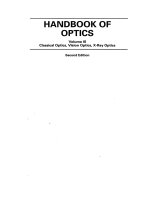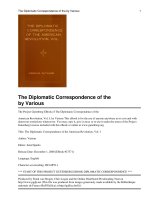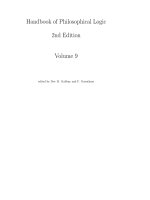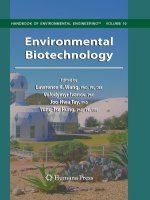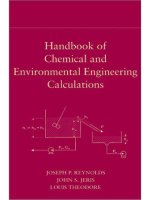Handbook of environmental isotope geochemistry vol i
Bạn đang xem bản rút gọn của tài liệu. Xem và tải ngay bản đầy đủ của tài liệu tại đây (15.86 MB, 974 trang )
Advances in Isotope Geochemistry
.
Mark Baskaran
Editor
Handbook of
Environmental Isotope
Geochemistry
Editor
Dr. Mark Baskaran
Wayne State University
Dept. Geology
Detroit Michigan
0224 Old Main Bldg
USA
ISBN 978-3-642-10636-1 (Printed in 2 volumes)
DOI 10.1007/ 978-3-642-10637-8
Springer Heidelberg Dordrecht London New York
e-ISBN 978-3-642-10637-8
Library of Congress Control Number: 2011935432
# Springer-Verlag Berlin Heidelberg 2011
This work is subject to copyright. All rights are reserved, whether the whole or part of the material is
concerned, specifically the rights of translation, reprinting, reuse of illustrations, recitation, broadcasting,
reproduction on microfilm or in any other way, and storage in data banks. Duplication of this publication or
parts thereof is permitted only under the provisions of the German Copyright Law of September 9, 1965, in
its current version, and permission for use must always be obtained from Springer. Violations are liable to
prosecution under the German Copyright Law.
The use of general descriptive names, registered names, trademarks, etc. in this publication does not imply,
even in the absence of a specific statement, that such names are exempt from the relevant pro-tective laws
and regulations and therefore free for general use.
Printed on acid-free paper
Springer is part of Springer Science+Business Media (www.springer.com)
To
The Founders, Architects and Builders
Of
Yesterday, Today and Tomorrow
Of
The Field “Isotope Geochemistry”
.
Endorsement from Prof. Gerald J. Wasserburg
“Environmental Science is concerned with chemical compounds
that effect the well being of society-where they come from, how they
are transported & where they are deposited. Isotopic geochemistry
plays a key role in deciphering this code. The approaches given in this
“Hand Book” give a clear view of answers, potential answers &
approaches in this field.”
G.J. Wasserburg, Caltech
Crafoord Laureate and John D. MacArthur Professor of Geology
and Geophysics, Emeritus
.
Endorsement from Prof. Alex Halliday
“The environment has never before been the focus of such fascination,
challenge and global engagement. Yet trying to comprehend it or
predict how it might evolve is difficult because of the complexities of
the systems. This is a volume of immense scope that provides up to
date information on the range of new isotopic tools that are being
developed and utilised to assail this issue. It is an invaluable reference
work that explains the range of techniques, the archives and the
discoveries, and should be of interest to any environmental scientist
who wants to explore and understand these same critical parts of
Earth’s surface.”
Alex N. Halliday FRS
Head, Mathematical, Physical and Life Sciences Division
University of Oxford
.
Preface
Applications of concepts and methods of physics and chemistry to geology resulted
in the field of Isotope Geochemistry which has revolutionized our understanding of
our Earth system and our environment. When isotope techniques applied to understanding environmental changes that have taken place in the anthropocene, the
resultant field can be defined as Environmental Isotope Geochemistry. The applications of isotopes as tracers and chronometers have permeated not only every
sub-branch of geosciences, but also archaeology, anthropology and environmental
forensics.
Over the past three to four decades major developments in instrumentation have
resulted in high precision and sensitivity in the measurement of a large number of
radioactive and stable isotopes that are widely utilized as powerful tools in earth and
environmental science. These developments have opened-up new areas of research,
resulting in even widening and deepening knowledge of geochemical processes and
new discoveries.
The purpose of this two-set volume is to bring together the more recent applications of a much larger number of radioactive and stable isotopes in earth and
environmental science, compared to the previous efforts (detailed in Chap. 1),
which is necessitated by the rapid developments in the field from the broad expansion
of elements studied now and novel applications that have emerged. In this first mostcomprehensive edited volume, the 40 chapters that follow cover applications of 115
isotopes from Z = 1 to Z = 95 (hydrogen to americium; radioactive isotopes of 30
elements, stable isotopes of 27 elements, and both radioactive and stable nuclides of
9 elements) as environmental tracers and chronometers. The topics covered in this
Handbook include: the cycling, transport and scavenging of atmospheric constituents; the biogeochemical cycling of inorganic and organic substances in aqueous
systems; redox processes; the sources, fate, and transport of organic and inorganic
pollutants in the environment; material transport in various Earth’s sub-systems (viz.,
lithosphere, hydrosphere, atmosphere and biosphere); weathering and erosion studies; effective surface exposure ages; sediment dynamics; the chronology of inorganic
and organic substances; reconstruction of paleoclimate and paleoenvironment; water
mass mixing; tracing both the production and origin of food; tracing the sources of
pollutant metals in the human body; archaeology; and anthropology. We anticipate
that this handbook will serve as an excellent resource for veteran researchers,
graduate students, applied scientists in environmental companies, and regulators in
public agencies, reviewing many tried and tested techniques as well as presenting
state of the art advances in Environmental Isotope Geochemistry.
xi
xii
Preface
The field of Environmental Isotope Geochemistry is so vast that it is not possible
to cover every aspect of this field. The audience in this field includes atmospheric
scientists, geologists, hydrologists, oceanographers, limnologists, glaciologists, geochemists, biogeochemists, soil scientists, radiation and health physicists and it is our
hope that we have included in-depth chapters in this Handbook that are relevant to
everyone of this group.
This idea of editing this handbook was conceived in 2008 and the proposal was
submitted to the publisher in 2009 during my sabbatical leave as a Plummer Visiting
Research Fellow at St. Anne’s College, University of Oxford. I owe a special thanks to
Don Porcelli for inviting me to Oxford and for the countless discussions we have had
during my pleasant stay there. An advisory committee comprised of the following
scientists was formed to advise the editor in selecting topics and authors: Per Andersson
(Sweden), Joel Blum (USA), Thure Cerling (USA), Brian Gulson (Australia), Kastsumi
Hirose (Japan), Gi-Hoon Hong (South Korea), Carol Kendall (USA), Devendra Lal
(USA), Don Porcelli (UK), R. Ramesh (India), Henry Schwarcz (Canada), Peter
Swarzenski (USA), and Jing Zhang (China). I would like to thank the Editorial
Advisory Board members for thoughtful suggestions at various stages of this Handbook. I would like to specially thank Carol Kendall, Gi-Hoon Hong, Henry Schwarcz
and Peter Swarzenski for suggesting some key chapters for inclusion in this Handbook
that enhanced the overall breadth of coverage. S. Krishnaswami has been very helpful
in looking through the original list of topics and came forth with many good suggestions to improve the content of this handbook. My association with him over the past 28
years (first as one of my early advisors in graduate school at the Physical Research
Laboratory (PRL), in Ahmedabad, India) has been very enjoyable. I thank student
assistant Vineeth Mohan of my department for his editorial assistance with the manuscripts. We thank all of the 82 external reviewers who gave up their time for reviewing
all the manuscripts. Finally, I am deeply indebted to all the authors for their relentless
efforts in collectively producing a thorough comprehensive two-set volume of articles
with breadth and depth for a variety of audiences and their efforts will be highly
appreciated by students of yesterday, today and tomorrow.
Wayne State University
Detroit, Michigan, USA
Mark Baskaran
Contents
Volume I
Part I
Introductory Chapters
1
“Environmental Isotope Geochemistry”:
Past, Present and Future . . . . . . . . . . . . . . . . . . . . . . . . . . . . . . . . . . . . . . . . . . . . . . . . . . . 3
Mark Baskaran
2
An Overview of Isotope Geochemistry in Environmental Studies . . . .
D. Porcelli and M. Baskaran
3
Humans and Isotopes: Impacts and Tracers of Human
Interactions with the Environment . . . . . . . . . . . . . . . . . . . . . . . . . . . . . . . . . . . . . .
Karl K. Turekian
Part II
4
11
33
Isotopes as Tracers of Continental and Aquatic Processes
Lithium Isotopes as Tracers in Marine and Terrestrial
Environments . . . . . . . . . . . . . . . . . . . . . . . . . . . . . . . . . . . . . . . . . . . . . . . . . . . . . . . . . . . . .
K.W. Burton and N. Vigier
41
5
Meteoric 7Be and 10Be as Process Tracers in the Environment . . . . . . .
James M. Kaste and Mark Baskaran
61
6
Silicon Isotopes as Tracers of Terrestrial Processes . . . . . . . . . . . . . . . . . . .
B. Reynolds
87
7
Calcium Isotopes as Tracers of Biogeochemical Processes . . . . . . . . . . . 105
Laura C. Nielsen, Jennifer L. Druhan, Wenbo Yang,
Shaun T. Brown, and Donald J. DePaolo
8
Natural and Anthropogenic Cd Isotope Variations . . . . . . . . . . . . . . . . . . . 125
M. Rehk€amper, F. Wombacher, T.J. Horner, and Z. Xue
9
Stable Isotopes of Cr and Se as Tracers of Redox Processes
in Earth Surface Environments . . . . . . . . . . . . . . . . . . . . . . . . . . . . . . . . . . . . . . . . . 155
Thomas M. Johnson
10
Stable Isotopes of Transition and Post-Transition Metals
as Tracers in Environmental Studies . . . . . . . . . . . . . . . . . . . . . . . . . . . . . . . . . . . 177
Thomas D. Bullen
xiii
xiv
Contents
11
Applications of Osmium and Iridium as Biogeochemical
Tracers in the Environment . . . . . . . . . . . . . . . . . . . . . . . . . . . . . . . . . . . . . . . . . . . . . 205
Mukul Sharma
12
Applications of Stable Mercury Isotopes to Biogeochemistry . . . . . . . . 229
Joel D. Blum
13
Thallium Isotopes and Their Application to Problems
in Earth and Environmental Science . . . . . . . . . . . . . . . . . . . . . . . . . . . . . . . . . . . 247
Sune G. Nielsen and Mark Rehk€amper
14
Po-210 in the Environment: Biogeochemical Cycling
and Bioavailability . . . . . . . . . . . . . . . . . . . . . . . . . . . . . . . . . . . . . . . . . . . . . . . . . . . . . . . 271
Guebuem Kim, Tae-Hoon Kim, and Thomas M. Church
15
Applications of Groundwater Helium . . . . . . . . . . . . . . . . . . . . . . . . . . . . . . . . . . 285
J.T. Kulongoski and D.R. Hilton
16
Applications of Short-Lived Radionuclides (7Be, 210Pb, 210Po,
Cs and 234Th) to Trace the Sources, Transport Pathways
and Deposition of Particles/Sediments in Rivers,
Estuaries and Coasts . . . . . . . . . . . . . . . . . . . . . . . . . . . . . . . . . . . . . . . . . . . . . . . . . . . . . 305
J.Z. Du, J. Zhang, and M. Baskaran
137
17
Radium Isotope Tracers to Evaluate Coastal Ocean
Mixing and Residence Times . . . . . . . . . . . . . . . . . . . . . . . . . . . . . . . . . . . . . . . . . . . . 331
L. Zhang, J. Zhang, P.W. Swarzenski, and Z. Liu
18
Natural Radium and Radon Tracers to Quantify Water
Exchange and Movement in Reservoirs . . . . . . . . . . . . . . . . . . . . . . . . . . . . . . . . 345
C.G. Smith, P.W. Swarzenski, N.T. Dimova, and J. Zhang
19
Applications of Anthropogenic Radionuclides as Tracers
to Investigate Marine Environmental Processes . . . . . . . . . . . . . . . . . . . . . . 367
G.-H. Hong, T.F. Hamilton, M. Baskaran, and T.C. Kenna
20
Applications of Transuranics as Tracers and Chronometers
in the Environment . . . . . . . . . . . . . . . . . . . . . . . . . . . . . . . . . . . . . . . . . . . . . . . . . . . . . . 395
Michael E. Ketterer, Jian Zheng, and Masatoshi Yamada
21
Tracing the Sources and Biogeochemical Cycling of Phosphorus
in Aquatic Systems Using Isotopes of Oxygen in Phosphate . . . . . . . . . 419
Adina Paytan and Karen McLaughlin
22
Isotopic Tracing of Perchlorate in the Environment . . . . . . . . . . . . . . . . . . 437
Neil C. Sturchio, John Karl Bo¨hlke, Baohua Gu,
Paul B. Hatzinger, and W. Andrew Jackson
23
The Isotopomers of Nitrous Oxide: Analytical Considerations
and Application to Resolution of Microbial
Production Pathways . . . . . . . . . . . . . . . . . . . . . . . . . . . . . . . . . . . . . . . . . . . . . . . . . . . . 453
Nathaniel E. Ostrom and Peggy H. Ostrom
Contents
xv
24
Using Cosmogenic Radionuclides for the Determination
of Effective Surface Exposure Age and Time-Averaged
Erosion Rates . . . . . . . . . . . . . . . . . . . . . . . . . . . . . . . . . . . . . . . . . . . . . . . . . . . . . . . . . . . . . 477
D. Lal
25
Measuring Soil Erosion Rates Using Natural (7Be, 210Pb)
and Anthropogenic (137Cs, 239,240Pu) Radionuclides . . . . . . . . . . . . . . . . . . 487
Gerald Matisoff and Peter J. Whiting
26
Sr and Nd Isotopes as Tracers of Chemical
and Physical Erosion . . . . . . . . . . . . . . . . . . . . . . . . . . . . . . . . . . . . . . . . . . . . . . . . . . . . 521
Gyana Ranjan Tripathy, Sunil Kumar Singh, and S. Krishnaswami
27
Constraining Rates of Chemical and Physical Erosion
Using U-Series Radionuclides . . . . . . . . . . . . . . . . . . . . . . . . . . . . . . . . . . . . . . . . . . . 553
Nathalie Vigier and Bernard Bourdon
Volume II
Part III
Isotopes as Tracers of Atmospheric Processes
28
Applications of Cosmogenic Isotopes as Atmospheric Tracers . . . . . . 575
D. Lal and M. Baskaran
29
Uranium, Thorium and Anthropogenic Radionuclides
as Atmospheric Tracers . . . . . . . . . . . . . . . . . . . . . . . . . . . . . . . . . . . . . . . . . . . . . . . . . 591
K. Hirose
30
Oxygen Isotope Dynamics of Atmospheric Nitrate
and Its Precursor Molecules . . . . . . . . . . . . . . . . . . . . . . . . . . . . . . . . . . . . . . . . . . . . 613
Greg Michalski, S.K. Bhattacharya, and David F. Mase
Part IV
Isotopes as Tracers of Environmental Forensics
31
Applications of Stable Isotopes in Hydrocarbon Exploration
and Environmental Forensics . . . . . . . . . . . . . . . . . . . . . . . . . . . . . . . . . . . . . . . . . . . 639
R. Paul Philp and Guillermo Lo Monaco
32
Utility of Stable Isotopes of Hydrogen and Carbon as Tracers
of POPs and Related Polyhalogenated Compounds
in the Environment . . . . . . . . . . . . . . . . . . . . . . . . . . . . . . . . . . . . . . . . . . . . . . . . . . . . . . 679
W. Vetter
Part V
Isotopes as Tracers in Archaeology and Anthropology
33
Light-Element Isotopes (H, C, N, and O) as Tracers
of Human Diet: A Case Study on Fast Food Meals . . . . . . . . . . . . . . . . . . . 707
Lesley A. Chesson, James R. Ehleringer, and Thure E. Cerling
34
Stable Isotopes of Carbon and Nitrogen as Tracers
for Paleo-Diet Reconstruction . . . . . . . . . . . . . . . . . . . . . . . . . . . . . . . . . . . . . . . . . . 725
H.P. Schwarcz and M.J. Schoeninger
xvi
Contents
35
Applications of Sr Isotopes in Archaeology . . . . . . . . . . . . . . . . . . . . . . . . . . . . 743
N.M. Slovak and A. Paytan
36
Sources of Lead and Its Mobility in the Human Body
Inferred from Lead Isotopes . . . . . . . . . . . . . . . . . . . . . . . . . . . . . . . . . . . . . . . . . . . . 769
Brian L. Gulson
Part VI
37
Isotopes as Tracers of Paleoclimate and Paleoenvironments
Dating of Biogenic and Inorganic Carbonates Using
Pb-226Ra Disequilibrium Method: A Review . . . . . . . . . . . . . . . . . . . . . . . 789
Mark Baskaran
210
38
Isotope Dendroclimatology: A Review with a Special
Emphasis on Tropics . . . . . . . . . . . . . . . . . . . . . . . . . . . . . . . . . . . . . . . . . . . . . . . . . . . . 811
S.R. Managave and R. Ramesh
39
The N, O, S Isotopes of Oxy-Anions in Ice Cores and Polar
Environments . . . . . . . . . . . . . . . . . . . . . . . . . . . . . . . . . . . . . . . . . . . . . . . . . . . . . . . . . . . . 835
Joe¨l Savarino and Samuel Morin
40
Stable Isotopes of N and Ar as Tracers to Retrieve Past
Air Temperature from Air Trapped in Ice Cores . . . . . . . . . . . . . . . . . . . . . 865
A. Landais
Author Index . . . . . . . . . . . . . . . . . . . . . . . . . . . . . . . . . . . . . . . . . . . . . . . . . . . . . . . . . . . . . . . . . . . 887
Subject Index . . . . . . . . . . . . . . . . . . . . . . . . . . . . . . . . . . . . . . . . . . . . . . . . . . . . . . . . . . . . . . . . . . 939
Contributors
W. Andrew Jackson
Texas Tech University, Lubbock, TX 79409, USA
M. Baskaran Department of Geology, Wayne State University, Detroit, MI 48202,
USA,
S.K. Bhattacharya Physical Research Laboratory, Navrangpura, Ahmedabad,
India,
Joel D. Blum Department of Geological Sciences, University of Michigan, 1100
North University Avenue, Ann Arbor, MI 48109, USA,
Bernard Bourdon Institute of Geochemistry and Petrology, Clausiusstrasse 25
ETH Zurich, Zurich 8092, Switzerland,
Shaun T. Brown Earth Sciences Division, Lawrence Berkeley National
Laboratory, Berkeley, CA 94720, USA
Thomas D. Bullen U.S. Geological Survey, MS 420, 345 Middlefield Road, Menlo
Park, CA 94025, USA,
K.W. Burton Department of Earth Sciences, Durham University, Science Labs,
Durham, DH1 3LE, UK,
Thure E. Cerling IsoForensics Inc, Salt Lake City, UT 84108, USA; Department
of Biology, University of Utah, Salt Lake City, UT 84112, USA; Department
of Geology and Geophysics University of Utah, Salt Lake City, UT 84112, USA,
Lesley A. Chesson IsoForensics Inc, Salt Lake City, UT 84108, USA;
Department of Biology University of Utah, Salt Lake City, UT 84112, USA,
Thomas M. Church College of Earth, Ocean, and Environment, University of
Delaware, Newark, DE, USA,
Donald J. DePaolo Department of Earth and Planetary Science, University of
California, Berkeley, CA 94720, USA; Earth Sciences Division Lawrence
Berkeley National Laboratory, Berkeley, CA 94720, USA, depaolo@eps.
berkeley.edu
N. Dimova UC-Santa Cruz/US Geological Survey, 400 Natural Bridges Drive,
Santa Cruz, CA, USA,
xvii
xviii
Contributors
Jennifer L. Druhan Department of Earth and Planetary Science, University of
California, Berkeley, CA 94720, USA; Earth Sciences Division Lawrence Berkeley
National Laboratory, Berkeley, CA 94720, USA
J.Z. Du State Key Laboratory of Estuarine and Coastal Research, East China
Normal University, Shanghai 200062, China,
James R. Ehleringer IsoForensics Inc, Salt Lake City, UT 84108, USA;
Department of Biology University of Utah, Salt Lake City, UT 84112, USA,
Baohua Gu
Oak Ridge National Laboratory, Oak Ridge, TN 37831, USA
Brian L. Gulson Graduate School of the Environment, Macquarie University,
Sydney, NSW 2109, Australia,
T.F. Hamilton Center for Accelerator Mass Spectrometry, Lawrence Livermore
National Laboratory, Livermore, CA 94551-0808, USA,
Paul B. Hatzinger
Shaw Environmental, Inc., Lawrenceville, NJ 08648, USA
D.R. Hilton Scripps Institution of Oceanography, University of California, San
Diego, La Jolla, CA 92093-0244, USA,
K. Hirose Department of Materials and Life Sciences, Sophia University,
7-1 Kioicho, Chiyodaku, Tokyo 102-8554, Japan,
G.-H Hong Korea Ocean Research and Development Institute, Ansan P.O.Box 29
Kyonggi 425-600, South Korea,
T.J. Horner Department of Earth Sciences, University of Oxford, Oxford OX1
3AN, UK,
Thomas M. Johnson Department of Geology, University of Illinois at UrbanaChampaign, Urbana, IL 61801, USA,
John Karl Bo¨hlke
U.S. Geological Survey, Reston, VA 20192, USA,
James M. Kaste Department of Geology, The College of William & Mary,
Williamsburg, VA 23187, USA,
T.C. Kenna Lamont-Doherty Earth Observatory, Columbia University, Palisades,
NY 10964, USA,
Michael E. Ketterer Department of Chemistry and Biochemistry, Box 5698,
Northern Arizona University, Flagstaff, AZ 86011-5698, USA, Michael.
Guebuem Kim School of Earth and Environmental Sciences, Seoul National
University, Seoul, South Korea,
Tae-Hoon Kim School of Earth and Environmental Sciences, Seoul National
University, Seoul, South Korea,
S Krishnaswami Geosciences Division,
Ahmedabad 380009, India,
Physical
Research
Laboratory,
Contributors
xix
J.T. Kulongoski California Water Science Center, U.S. Geological Survey, San
Diego, CA 92101, USA,
D. Lal Geosciences Research Division, Scripps Institution of Oceanography, 9500
Gilman Drive, La Jolla, CA 92093-0244, USA; Scripps Institution of Oceanography
University of California, San Diego, CA 92093, USA,
A. Landais Institut Pierre Simon Laplace/Laboratoire des Sciences du Climat et de
l’Environnement, CEA/CNRS/UVSQ, Orme des Merisiers, 91191 Gif sur Yvette,
France,
Z. Liu Key Laboratory of Marine Environment and Ecology (Ocean University of
China), Ministry of Education, 238 Songling Road, Qingdao 266003, P.R. China,
Guillermo Lo Monaco School of Geology and Geophysics, University of
Oklahoma, Norman, OK 73019, USA
S.R. Managave Presently at Department of Earth Sciences, Pondicherry
University, R.V. Nagar, Kalapet, Puducherry 605014,
David F. Mase Purdue University, 550 Stadium Mall Drive, West Lafayette, IN
47907-1210, USA,
Gerald Matisoff Department of Geological Sciences, Case Western Reserve
University, Cleveland, OH 44106-7216, USA,
Karen McLaughlin Southern California Coastal Water Research Project, Costa
Mesa, CA 92626, USA,
Greg Michalski Purdue University, 550 Stadium Mall Drive, West Lafayette, IN
47907-1210, USA,
Samuel Morin Institut National des Sciences de l’Univers, CNRS, Grenoble,
France; Me´te´o-France CNRM-GAME, Centre d’E´tudes de la Neige, St Martin
d’He`res, France,
Sune G. Nielsen Woods Hole Oceanographic Institution, Dept. Geology and
Geophysics, 02543 Woods Hole, MA, USA,
Laura C. Nielsen Department of Earth and Planetary Science, University of
California, Berkeley, CA 94720, USA; Earth Sciences Division, Lawrence
Berkeley National Laboratory, Berkeley, CA 94720, USA,
Nathaniel E. Ostrom Department of Zoology, Michigan State University,
204 Natural Sciences Building, East Lansing, MI 48824, USA,
Peggy H. Ostrom Department of Zoology, Michigan State University, 204 Natural
Sciences Building, East Lansing, MI 48824, USA,
Adina Paytan University of California, Santa Cruz, CA 95064, USA,
R. Paul Philp School of Geology and Geophysics, University of Oklahoma,
Norman, OK 73019, USA,
xx
Contributors
D. Porcelli Department of Earth Sciences, Oxford University, South Parks Road,
Oxford OX1 3AN, UK,
R. Ramesh Geosciences Division, Physical Research Laboratory, Navrangpura,
Ahmedabad 380009, India,
Mark Rehk€amper Department of Earth Science and Engineering, Imperial
College, London SW7 2AZ, UK,
B. Reynolds Institute for Geochemistry and Petrology, ETH Zurich, Switzerland,
Joe¨l Savarino Laboratoire de Glaciologie et Ge´ophysique de l’Environnement,
Universite´ Joseph Fourier, St Martin d’He`res, France; Institut National des Sciences
de l’Univers CNRS, Grenoble, France,
M.J. Schoeninger University of California at San Diego, 9500 Gillman Drive,
La Jolla, CA 92093, USA,
H.P. Schwarcz School of Geography and Earth Sciences, McMaster University,
Hamilton ON L8S 4K1, Canada,
Mukul Sharma Radiogenic Isotope Geochemistry Laboratory, Department of
Earth Sciences, Dartmouth College, 6105 Fairchild Hall, Hanover, NH 03755,
USA,
Sunil Kumar Singh Geosciences Division, Physical Research Laboratory,
Ahmedabad 380009, India,
N.M. Slovak Department of Behavioral Sciences, Santa Rosa Junior College, 1501
Mendocino Avenue, Santa Rosa, CA, USA,
C.G. Smith US Geological Survey, 600 4th Street South, St. Petersburg, FL, USA,
Neil C. Sturchio
University of Illinois at Chicago, Chicago, IL 60607, USA,
P.W. Swarzenski US Geological Survey, 400 Natural Bridges Drive, Santa Cruz,
CA 95060, USA,
Gyana Ranjan Tripathy Geosciences Division, Physical Research Laboratory,
Ahmedabad 380009, India,
Karl K. Turekian Department of Geology and Geophysics, Yale University,
New Haven, CT 06511, USA,
W. Vetter University of Hohenheim, Institute of Food Chemistry, Garbenstrasse
28, 70599 Stuttgart, Germany,
Nathalie Vigier CRPG-CNRS, Nancy Universite´, 15 rue Notre Dame des Pauvres,
54500 Vandoeuvre les Nancy, France,
Peter J. Whiting Department of Geological Sciences, Case Western Reserve
University, Cleveland, OH 44106-7216, USA,
Contributors
xxi
F. Wombacher Institut f€ur Geologie und Mineralogie, Universit€at zu Ko¨ln,
Z€
ulpicher Straße 49b 50674, Ko¨ln, Germany,
Z. Xue Department of Earth Science and Engineering, Imperial College London,
London SW7 2AZ, UK,
Masatoshi Yamada Environmental Radiation Effects Research Group, National
Institute of Radiological Sciences, 4-9-1 Anagawa, Inage, Chiba 263-8555, Japan
Wenbo Yang Department of Earth and Planetary Science, University of
California, Berkeley, CA 94720, USA; Earth Sciences Division, Lawrence
Berkeley National Laboratory, Berkeley, CA 94720, USA
J. Zhang State Key Laboratory of Estuarine and Coastal Research, East China
Normal University, Shanghai 200062, China,
Jian Zheng Environmental Radiation Effects Research Group, National Institute
of Radiological Sciences, 4-9-1 Anagawa, Inage, Chiba 263-8555, Japan,
.
Part I
Introductory Chapters
.



